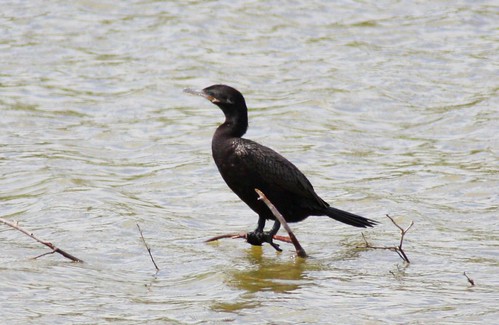While the neighborhood is only a few blocks off one of Houston's major freeways, the park itself is tucked into the farthest corner of that subdivision. Two edges of this small playground and shaded area are bordered by several acres of trees and heavy undergrowth, and the back side of the park runs up against White Oaks Bayou. Directly across the bayou from the park is another small wooded area where I have seen several hawks and kestrels roost from time to time. Next to this stand of trees and connected to the bayou is an enormous flood control area where, during rainier seasons, a large number of egrets can often be found; however, since the flood area is shallower than the bayou at this point, it does not hold standing water except after heavy rains.
I got a little more adventurous one day last week, and for the first walked down the bayou from the park for a half mile or so. Much to my surprise, I discovered a second flood control area hidden away back here, completely closed off from the surrounding roads and neighborhoods by small forested tracts. This section has a small standing "lake," complete with a small island and a number of large nesting trees right near the water's edge.
And while most of the Houston area is bone dry at the moment, this sheltered little paradise is thriving. I encountered a handful of Red-shouldered Hawks patrolling the surrounding trees, a Belted Kingfisher (who on three occasions moved from his cover in trees near the lake to soar down a long length of the adjacent bayou and back), several Snowy Egrets and — biggest surprise, to me anyways — four Double-crested Cormorants. I have never before seen cormorants this close to highly populated areas.

Double-crested Cormorant (Phalacrocorax auritus)


You can be sure that I will be returning to this hideaway habitat on a fairly regular basis, whenever the time allows.
For more great bird photos from around the world, check out Bird Photography Weekly #28.








4 comments:
That's a great discovery you got there, Kyle! I'm expecting many more posts (and pictures) from that place soon.
Congratulation on your new finding of beautiful Cormorant. I like the last flying one.
Hey Kyle--
These are nice shots, but they're Neotropic Cormorants, not Double-cresteds. Hope this comes as a pleasant surprise!
Check the slanted (not straight) border to the gular pouch and the white line of feathers bordering it--both Neotropic features.
Jeff
Jeff, thanks for the ID help! I am even more excited to know that we have Neotropic Cormorants this far north and inland.
I had initially decided these were Neotropics when I spotted them, but in looking at the pictures on the (old) Cornell site I became a little less convinced. Their photos of both Double-crested and Neotropic Cormorants showed the white line of feathers bordering the gular, and so I tried going by the tail length. Well, that and the fact that I really didn't expect to see Neotropics here.
I've seen 2-4 of these on each visit to this site since I first found the area -- up to and including yesterday's visit -- and I'm hoping they will prove to be long-term residents.
Post a Comment